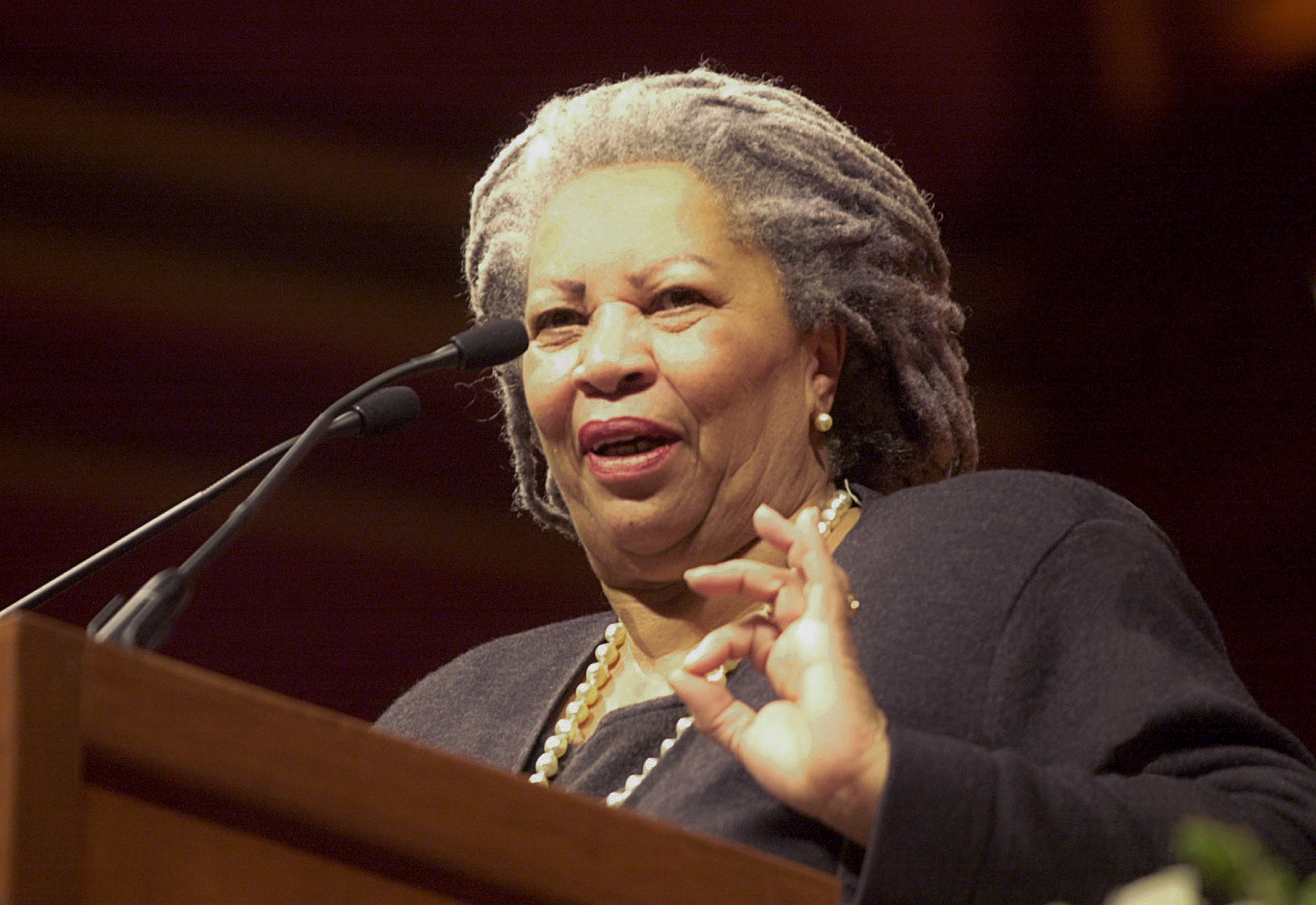
Pulitzer and Nobel Prize-winning author Toni Morrison delivered this year’s fifth Radcliffe Institute Inaugural Lecture Tuesday to a Sanders Theatre crowd of about 1,000. Morrison said she writes without self-imposed restrictions, feeling that her writing is one place she can be free: “That’s the place I have no fear. That’s the one place I feel I can do anything, remember anything, invent anything, and push them together.”
Jon Chase/Harvard Staff Photographer
Morrison talks race and gender
Relationships between black and white women in literature have provided a sometimes painful mirror of racial stereotypes in the real world, Nobel Prize-winning author Toni Morrison said Tuesday, concluding, however, that literature today has gotten beyond stereotypes, no longer mirroring reality but running ahead of it.
“Writers have already said farewell … to the racial anchor that weighed down the language from its imaginative possibilities,” Morrison said. “How nice it would be, at least in this case, if life could imitate art.”
Morrison, one of the country’s top authors and winner of both the Pulitzer and Nobel prizes, delivered this year’s fifth Radcliffe Institute Inaugural Lecture to an enthusiastic Sanders Theatre crowd of about 1,000, including Harvard President Neil L. Rudenstine and Radcliffe Dean Drew Gilpin Faust.
The lecture series marks the creation of the Radcliffe Institute for Advanced Study, formed out of the merger of Radcliffe College and Harvard University.
Morrison was introduced by Barbara Johnson, a professor in the Department of English and American Literature and Language and the Fredric Wertham Professor of Law and Psychiatry in Society.
“It is no exaggeration to say Toni Morrison is the most celebrated author in the United States. She has written seven novels, several books of criticism, and some astonishing short stories,” Johnson said, adding that Morrison’s impact is as broad among college students as it is in the general public. “Only Shakespeare rivals her in the number of senior theses devoted to her work.”
Morrison’s talk was academic in tone and used the complex, evocative language she is known for in her novels, such as “Beloved,” which won the 1988 Pulitzer Prize for Fiction, and “Song of Solomon,” which won the 1977 National Book Critic’s Circle Award.
Morrison set the stage for her talk by describing a television interview in which she wanted to discuss topics other than race. The interviewer initially agreed, but then reneged, saying that the racial angle for a prominent black woman author could not be ignored.
“I do know that racial difference is a very, very big subject. But the point is that he wasn’t interested in any aspect of me other than the racial one,” Morrison said. “I have a yearning for a certain environment in which I can speak and write without every sentence I form being understood as mere protest or mere advocacy.”
Morrison segued to a more in-depth discussion of relationships between black and white women in literature over the last several decades. She began with a description of a Kenyan woman in Isak Dinesen’s “Out of Africa” that compared the woman with a giraffe and a cow. Morrison moved back and forth through time, touching on, among other works, Margaret Mitchell’s “Gone With the Wind” and Willa Cather’s “Sapphira and the Slave Girl.”
In discussing the topic, Morrison read a passage from “Beloved,” perhaps her most famous work, which was made into a 1998 movie of the same name. In talking about the relationship between Sethe, an escaped slave who is having a baby, and Amy, a white girl who briefly befriends her, Morrison said she was trying to make a point that had the two not been separated by the chasm of race, they might have become companions.
“Washing up on the banks of Ohio River is our knowing that if both women had been of the same race, both white, both black, they could have, would have, stayed together a little while and shared their fortune,” Morrison said.
In answering questions from the audience, Morrison also discussed her own writing, saying it is a way for her to work out issues.
“I start with a free-floating idea and then I have to find the structure [to tell the story],” Morrison said. “Generally, it’s just some huge, inarticulate idea I have about something that I want to work out, a philosophical question I need to work out.”
Morrison said she writes without self-imposed restrictions, feeling that her writing is one place she can be free.
“That’s the place I have no fear,” Morrison said. “That’s the one place I feel I can do anything, remember anything, invent anything, and push them together.”
Morrison’s academic tone stymied some in the audience, who confessed they didn’t understand everything she said. But that didn’t prevent her receiving standing ovations at both the beginning and the end of her speech.
Morrison’s drawing power extended well beyond the University, with people traveling from across the region to hear her talk.
“It was wonderful. I traveled here from New York just to hear her,” said Carol Dixon, director of the John Oliver Killens Writers Workshop in New York City. “She said art is political and it ought to be beautiful. Her work illustrates that to us.”




